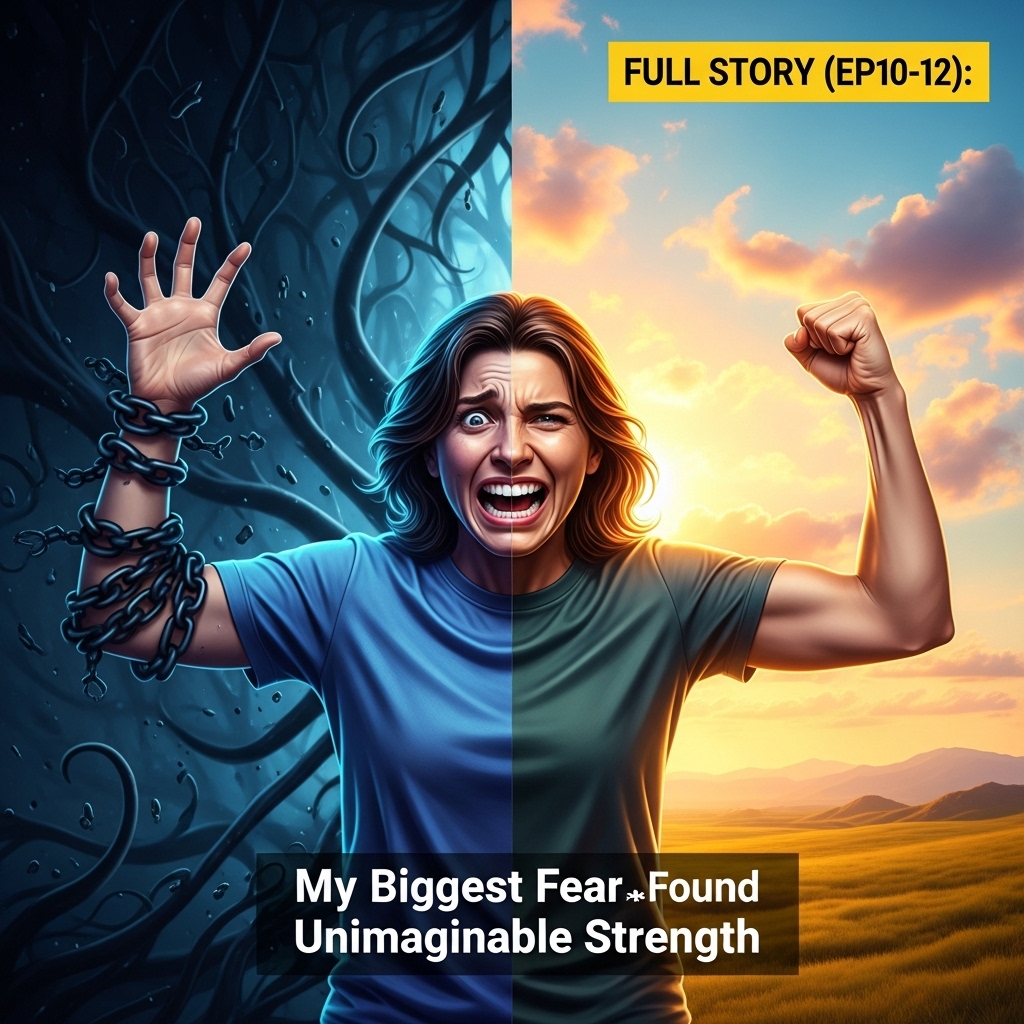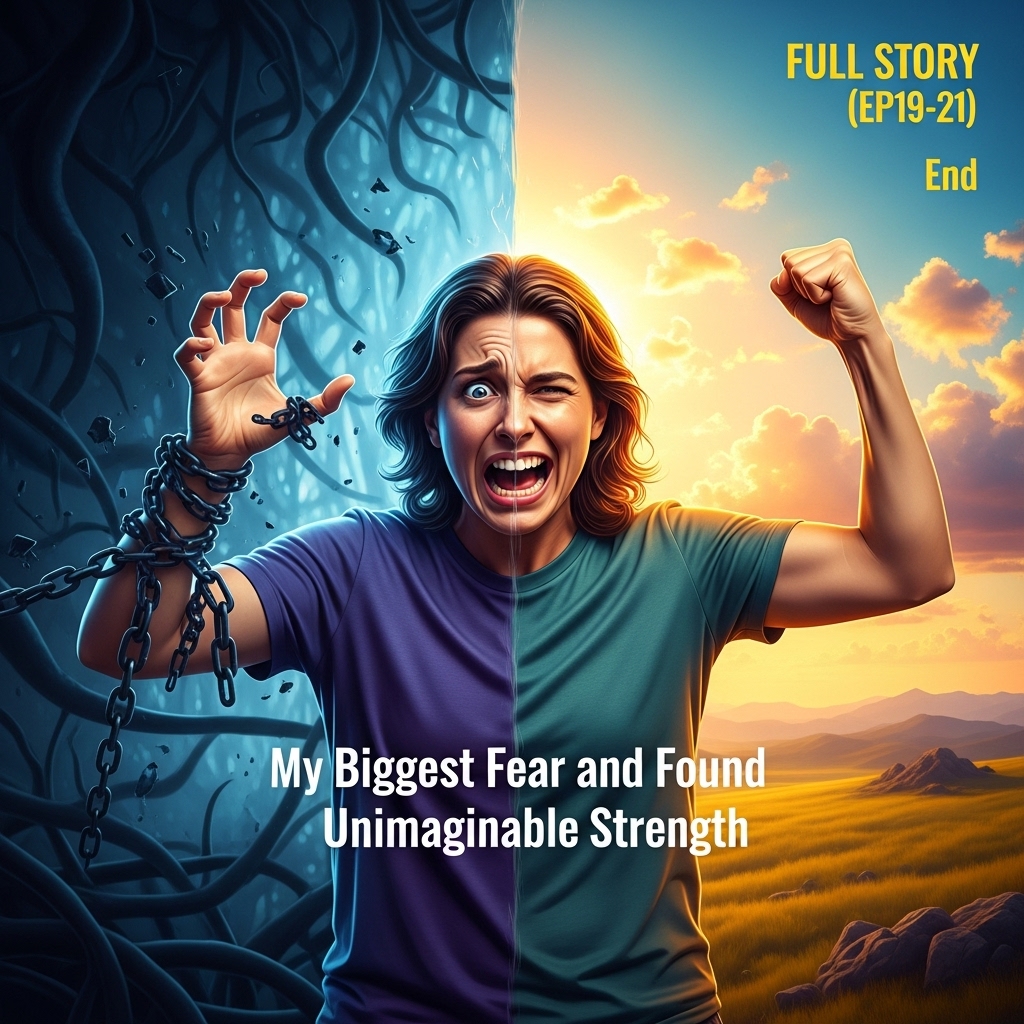Episode: 10
This internaltug-of-war was exhausting. My spirit was weary from the constant internal accusations and the relentless pressure to perform, to overcome, to “just be brave.” But beneath the weariness, a more potent, primal emotion began to stir: desperation. It was a quiet, cold kind of desperation, not the frantic, flailing kind, but the deep, bone-tired yearning for an end to the struggle, for a moment of peace, for a hint of a path forward. This desperation, more than any logic or intellectual argument, became the true catalyst for change. It was the overwhelming need for relief that finally silenced the insistent whispers of pride and shame.
One evening, after another particularly soul-crushing setbackthat left me staring blankly at the ceiling for hours, the thought crystallised with a quiet, undeniable force: *I cannot do this alone*. It wasn’t a defeat; it was a revelation. It was the understanding that myfear wasn’t a simple obstacle to be bulldozed, but a complex tapestry woven from years of experience, belief, and protection. And to unravel such a tapestry, I needed a different kind of tool, and a different kind of guide. I needed someone who understood the intricate patterns, someone who could see beyond the tangled threads to the original design.
The very act of acknowledging this need, even if only to myself in the stillness of the night, felt like taking a monumentalfirst step. It was the crack in the façade, the admission that the lone warrior approach, though romantic in theory, was utterly unsustainable in practice. But admitting the need for help was only the beginning. The next hurdle was understanding *whatkind* of help was truly necessary. This wasn’t a physical injury that needed a doctor, nor a simple problem that required a quick fix. This was something woven into the very fabric of my being, something deeply psychological and emotional. Ineeded someone who could navigate the labyrinth of the mind, someone who understood the whispers of the subconscious and the echoes of the past.
My initial research was tentative, filled with skepticism and a healthy dose of fear. The internet, a vastocean of information and misinformation, offered a dizzying array of options: life coaches, spiritual gurus, hypnotherapists, traditional therapists, counselors of every stripe. Each seemed to promise a different pathway to liberation, and each seemed to demanda leap of faith I wasn’t sure I possessed. I worried about charlatans, about wasted time, about investing my dwindling emotional and financial resources into something that might ultimately leave me more disheartened than before. The fear, evercunning, tried to creep back in, attempting to convince me that this pursuit of help was just another form of escapism, another way to avoid the *real* confrontation.
But the quiet desperation held firm. It reminded me that the alternative— continuing down the same failing path — was far more terrifying. So, I started small. I read articles, watched videos, and listened to podcasts. I sifted through testimonials, looking not for grand pronouncements of instant cures, but for storiesof gradual, messy progress, of real people struggling and slowly finding their way. I was looking for authenticity, for an approach that resonated with my own internal sense of logic and empathy.
I remember one particular evening, scrolling through profiles of various therapists.Many felt too clinical, too detached, or conversely, too aggressively positive in a way that felt disingenuous. I was looking for someone who conveyed both compassion and competence, someone who seemed capable of holding space for both the darkness and thelight within. And then, I found a profile. It belonged to a woman named Dr. Eleanor Vance. Her photo showed kind eyes, framed by a quiet, thoughtful expression. Her approach, as described on her page, emphasized a holisticunderstanding of fear and anxiety, combining cognitive-behavioral techniques with a focus on self-compassion and understanding the body’s wisdom. What struck me most was a phrase she used: “We don’t conquer our shadows; we learn towalk with them.” This resonated deeply with my newfound understanding that the fear wasn’t an external enemy to be vanquished, but something intertwined with my own story.
The decision to schedule that first consultation was monumental. My finger hovered over the “bookappointment” button for what felt like an eternity. Each beat of my heart was a tiny drum announcing the imminent crossing of a threshold. What if she judged me? What if she thought my fear was trivial, or worse, insurmountable? What if shecouldn’t help? But the silence of my apartment, the lingering echo of past failures, pushed me forward. The risk of trying felt less daunting than the certainty of remaining stuck. I took a deep breath, and I clicked.
The waitingperiod before the first session was an odd mix of anxiety and a fragile hope. I meticulously prepared a mental list of all the aspects of my fear, determined to articulate it perfectly, to leave no stone unturned in explaining the depth of mypredicament. Yet, beneath this preparation, there was a nascent sense of anticipation, a feeling that something significant was about to change.
The first session with Dr. Vance was not a dramatic turning point, not an instant revelation that swept away all my worries. It was far more subtle, and in its subtlety, far more profound. I remember her office being warm and inviting, filled with natural light, a stark contrast to the dark, internal spaces my fear often created. She listened with anattentiveness that felt rare and deeply validating. I poured out my story, the genesis of the fear, the repeated failures, the shame, the exhaustion. And she listened, not interrupting, not judging, but simply absorbing my narrative.When I finally finished, expecting perhaps a clinical analysis or a stern suggestion, her response was unexpectedly gentle. “It sounds like you’ve been carrying an incredibly heavy burden,” she said softly, her voice calm and steady. “And itsounds like a very understandable response to what you’ve experienced.”
Those words, “understandable response,” landed like a balm on an open wound. For so long, I had viewed my fear as a personal failing, a character flaw, a signof weakness. To hear it reframed as an “understandable response” was revolutionary. It immediately shifted my perspective, even if only slightly, from self-blame to a nascent sense of self-compassion. It was the first quietwhisper that perhaps I wasn’t broken, but rather, I had developed a coping mechanism that, while once protective, had now become restrictive.
This initial interaction set the tone for what would become a sustained period of transformative work. Dr. Vancedidn’t offer quick fixes or platitudes. Instead, she offered a framework for understanding, a map for navigating, and a compassionate presence that allowed me to finally lower my guard. She introduced me to the concept of the “shadow”not as an enemy to be destroyed, but as an aspect of myself that was demanding attention, often in uncomfortable ways. She explained that fear, at its core, often serves a protective function, a warning system designed to keep us safe. Theproblem, she elucidated, was when that system became overactive, misinterpreting benign situations as threats, or when its alarms became so loud that they paralyzed us entirely.
Episode: 11
This reframing was incredibly powerful. It allowed me to beginseeing my fear not as a monstrous entity lurking in the dark, but as a misguided protector, a part of me that was trying, however clumsily, to keep me out of harm’s way. This subtle shift from adversary to misguidedally was monumental. It began to dismantle the internal battleground, replacing the fight with a potential for dialogue, for understanding.
She introduced me to various tools, not as immediate cures, but as practices to cultivate over time. The firstand perhaps most foundational was mindfulness. I had heard the term before, of course, but had always dismissed it as a nebulous, New Age concept. Dr. Vance presented it not as an escape from reality, but as a deeper engagement with it. She taught me simple breathing exercises, techniques to ground myself in the present moment, to observe my thoughts and feelings without judgment, rather than being swept away by them.
“Think of your mind as a busy street,” she would explain gently. “You can stand in the middle of the traffic, letting every car almost hit you, or you can step back onto the sidewalk and observe the flow without getting run over.” This analogy helped me visualize the separation between *me* and *my thoughts*. My fear was no longer *me*; it was a thought, a feeling, a sensation passing through. This distinction was incredibly liberating. It gave me a small but significant degree of agency. I could choose to observe, ratherthan be consumed.
We also delved into cognitive-behavioral techniques. This involved identifying the automatic negative thought patterns that accompanied my fear. For example, before even attempting a challenging situation, my mind would instantly jump to catastrophic conclusions: “I’m going to fail,” “Everyone will laugh,” “It’s going to be terrible.” Dr. Vance helped me to catch these thoughts, to question their validity, and to challenge them with more realistic, balanced perspectives. It was likelearning to be my own internal detective, examining the evidence, rather than simply accepting every fearful pronouncement as gospel truth.
This wasn’t easy work. It required immense self-awareness and a willingness to sit with discomfort. There were momentswhen I felt overwhelming frustration, when the old patterns felt too deeply ingrained, too powerful to shift. I’d leave sessions feeling emotionally drained, sometimes even more exposed than before. But Dr. Vance’s consistent presence, her unwavering beliefin my capacity for change, and her gentle guidance kept me moving forward. She normalized the setbacks, reminding me that healing wasn’t a linear process, but a winding path with many twists and turns.
One of the most profound shifts came fromunderstanding the physiological aspect of fear. She explained the “fight, flight, or freeze” response, how my body, wired for survival, was often reacting before my conscious mind had a chance to process the situation. This explained the sudden surgesof adrenaline, the racing heart, the shallow breath that often accompanied my fearful moments. Learning about this biological response helped demystify the physical symptoms, making them less terrifying. They were not signs of impending doom, but rather signals from a highlysensitive system. With this knowledge, I began to learn techniques to soothe my nervous system: deep belly breathing, progressive muscle relaxation, even simply splashing cold water on my face. These were small, practical actions that gave me a sense of control overmy own body, something I had previously felt utterly helpless against.
The therapeutic relationship itself became a cornerstone of my shifting perspective. In Dr. Vance’s office, I found a safe harbor, a space where I could express my deepest vulnerabilitieswithout fear of judgment. This unconditional acceptance was something I hadn’t realized I was missing, and it created fertile ground for growth. She wasn’t just a listener; she was a guide, an educator, and a compassionate mirror. She reflectedback to me strengths I couldn’t see, pointed out patterns I was blind to, and gently challenged limiting beliefs that had held me captive for years.
I began to keep a journal, a practice she strongly encouraged. It became a silentconfidante, a place to document the daily struggles, the small victories, and the emerging insights. In its pages, I tracked my thoughts, my emotional reactions, and my attempts at applying the new tools. This act of writing, of externalizingthe internal turmoil, brought a surprising clarity. I started to see patterns, to notice triggers, and to understand the ebb and flow of my fear with a level of detail I had never previously considered. It transformed the nebulous, overwhelming “fear” into something more defined, something I could begin to understand and, eventually, interact with more consciously.
One particular breakthrough moment occurred during a session where I was recounting a seemingly insignificant social interaction that had sent me spiraling into self-doubt.I was expressing immense frustration with myself for “still” reacting that way. Dr. Vance stopped me. “What if,” she asked softly, “instead of fighting that feeling, you just allowed it to be there for a moment? What if you acknowledgedthat part of you is still trying to protect you, even if clumsily? Can you offer that part of yourself some kindness?”
Her words caught me off guard. Kindness? To the part of me that caused so much pain? Itfelt counter-intuitive, almost like rewarding the enemy. But I tried it. I closed my eyes and imagined that fearful part of myself, not as a monstrous shadow, but as a small, scared child. And for the first time, insteadof berating it, I felt a flicker of tenderness, a whisper of compassion. It was a profound shift, a crack in the wall of self-criticism I had built around myself. It was the moment I truly began to understand thathealing wasn’t about eradicating parts of myself, but about integrating them, about offering understanding and acceptance to even the most uncomfortable emotions.
Episode: 12
This marked the true “shifting of gears.” It wasn’t about eradicating the fear,but about changing my relationship with it. It was about moving from a position of constant battle to one of curious observation, from self-condemnation to self-compassion, from isolation to seeking informed guidance. The path ahead was still longand uncertain, but for the first time in years, I felt a solid ground beneath my feet. I had a guide, a map, and a nascent understanding that the strength I sought wasn’t about being fearless, but about cultivating a differentkind of courage: the courage to be vulnerable, to ask for help, and to embark on a journey of profound self-discovery and acceptance. This pivotal moment wasn’t a destination; it was the true beginning of the expedition. The fearhadn’t vanished, not by any means, but its power over me had begun to diminish, replaced by a quiet, determined hope and a profoundly changed perspective.The insight gleaned from those sessions with Dr. Vance, the profound understanding that healing wasn’t about obliterating parts of myself, but about integrating them with compassion, truly marked the commencement of a new phase. It was the crucial “shifting ofgears” I spoke of, moving from an endless battle against an internal enemy to a more curious, more gentle approach. The fear hadn’t vanished, not by any stretch of the imagination, but its tyrannical grip on my life had begun toloosen. A quiet, determined hope had taken root, and for the first time in what felt like an eternity, I had a compass, a guide, and a nascent belief that I could navigate this treacherous terrain. This wasn’t merely achange in perspective; it was the foundation upon which the true work, the active confrontation, would be built. It was time for the leap of faith.
The idea of “taking a leap” often conjures images of a single, dramaticplunge into the unknown, a grand, courageous act that instantly transforms everything. But in my experience, the leap of faith wasn’t one monumental jump; it was a series of countless, smaller leaps, each one requiring its own measure of courage, eachone pushing the boundaries of my perceived limitations. Dr. Vance introduced me to the concept of a “fear ladder,” a methodical, step-by-step approach to facing the very thing that had held me captive. It wasn’t about divingheadfirst into the deepest, darkest waters of my anxiety; it was about wading in, inch by careful inch, allowing my system to acclimate, to learn, to adapt.
The first step on this ladder felt almost laughably small, yetit loomed as large as Mount Everest in my mind. Dr. Vance asked me to simply *imagine* the feared scenario, to conjure it in my mind’s eye for a mere five minutes, and observe my reactions without judgment.No action was required, no physical confrontation. Just observation. I remember sitting there, eyes closed, my breath catching in my throat as I mentally placed myself in a crowded, confined space. Instantly, the familiar physical sensations washed over me: atightening in my chest, a frantic pulse, the prickle of sweat on my palms. My mind, a skilled architect of disaster, began constructing elaborate escape routes, predicting every possible negative outcome. It felt utterly overwhelming, even in imagination.
But thistime, something was different. Instead of immediately recoiling or berating myself for the discomfort, I remembered Dr. Vance’s words: “Offer that part of yourself some kindness.” I consciously shifted my focus to my breath, allowing itto be a gentle anchor. I acknowledged the fear, naming it internally: “Ah, here you are, fear. Trying to protect me.” I imagined that small, scared child within me, and for those five agonizing minutes, I simplysat with the feeling, extending a silent, compassionate presence towards it. It was incredibly difficult, exhausting even, but when the timer chimed, I hadn’t fled. I had stayed. That small, internal act of endurance, ofnot running from the feeling, was my very first leap. It was a victory of immense significance, a quiet declaration that I could indeed tolerate discomfort, even if it felt like a storm raging within.
We repeated this exercise, gradually increasing the durationof the imagined scenarios, adding more sensory details, making them more vivid. We talked through the automatic negative thoughts, dissecting them, questioning their absolute truth. I learned to identify the “hot spots” of my anxiety, the specific triggers that sentmy system into overdrive. This foundational work was crucial, like stretching before a grueling race. It prepared me not just physically, but emotionally and psychologically, for the more tangible steps that lay ahead. It taught me that my mind, while capableof creating immense distress, was also capable of incredible self-regulation, given the right tools and a compassionate approach.
The next series of leaps involved what Dr. Vance called “in vivo” exposure, which simply meant facing the fear in real life, but in a carefully controlled and incremental manner. My biggest fear was related to specific types of crowded, confined spaces. So, the initial real-world steps were designed to be incredibly gentle, almost imperceptible to an outsider, but monumentalto me.
My second “leap” was to simply stand outside the entrance of a moderately busy supermarket, a place I had actively avoided for years. The objective wasn’t to go in, just to be *near* it. Iremember the day vividly. The sun was bright, the air crisp. As I approached the parking lot, the familiar wave of anticipatory anxiety began to crest. My heart hammered against my ribs, a desperate bird trying to escape its cage. My palmswere slick, my vision narrowing at the edges. Every person entering or exiting the store felt like a potential threat, every cart rattling past, a jarring noise. My mind screamed at me to turn back, to find a safer, quieter place. Thiswas irrational, it told me, dangerous, foolish.
But I had my tools. I stopped about fifty yards from the entrance, by a parked car, and leaned against it, deliberately bringing my awareness to my feet on the asphalt, thesolidness of the car against my back. I focused on my breath, the slow, steady rhythm, imagining it as a calming wave washing through my body. I mentally acknowledged the fear, *without judgment*. “Okay, fear, you’re here. I feel you. And I’m going to stay for five minutes.” It felt like an eternity. Each second stretched, viscous and heavy. I watched people, observing their mundane actions, trying to ground myself in thereality of the scene rather than the panic in my head.
When the five minutes were up, I didn’t feel a rush of triumph. I felt exhausted, shaky, but also profoundly relieved. I hadn’t run. I hadn’t succumbed. I had stood my ground, however small that ground was, and allowed the anxiety to surge, and then, inevitably, to recede. It was a powerful lesson: anxiety is not infinite. It peaks, and then it*always* comes down, especially when you don’t feed it with avoidance or panicked flight. This tiny victory, standing outside a supermarket, was another crack in the fortress of fear that had imprisoned me. It wasn’t about feelingfearless; it was about acting despite the fear, and learning that the feeling itself, however intense, wasn’t going to harm me.



